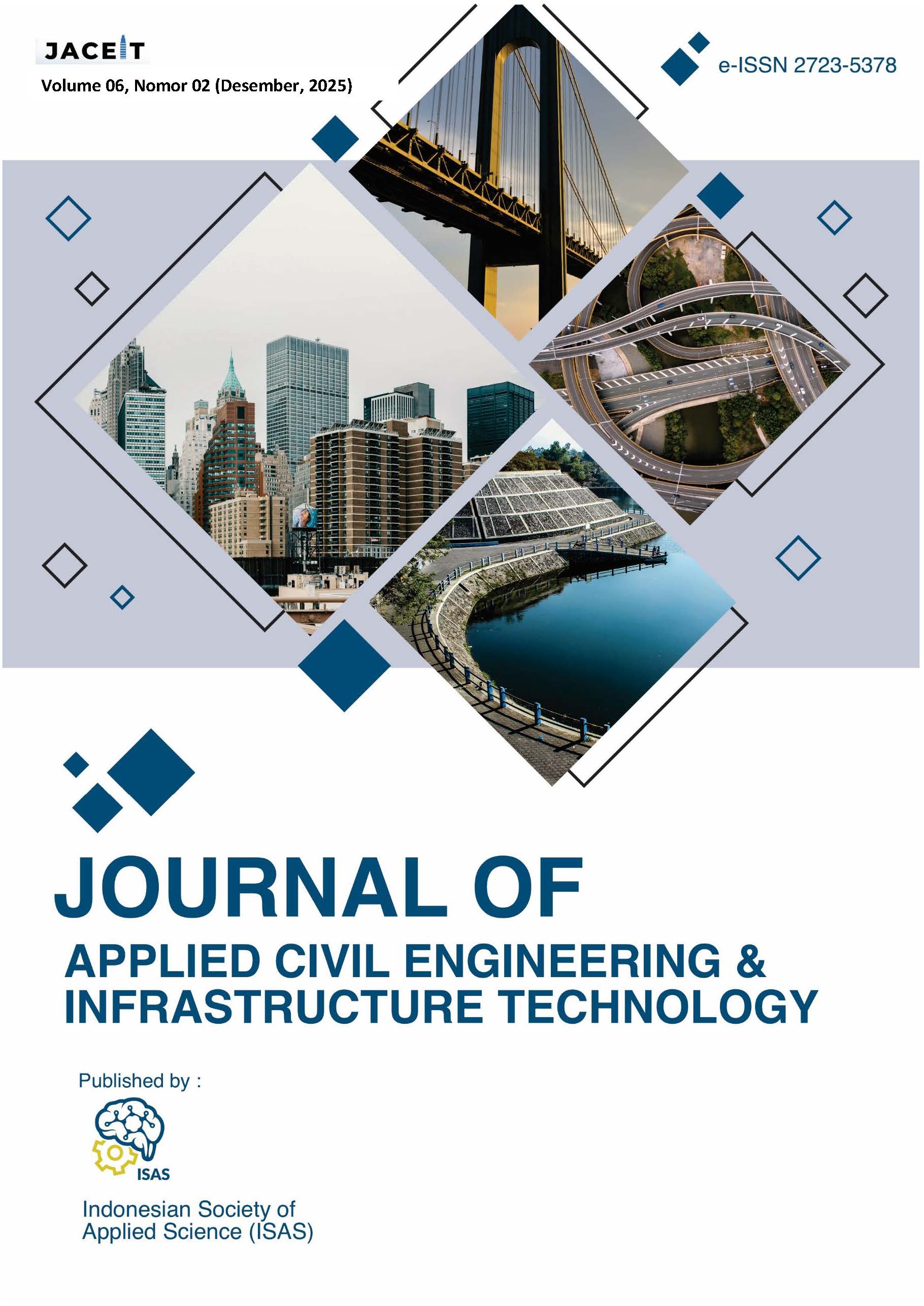Analisis Daya Serap Air Paving Block Dengan Polyethylene Terephthlate Sebagai Pengganti Semen
DOI:
https://doi.org/10.52158/jaceit.v6i2.1004Keywords:
Paving Block, Polyethylene Terephthlate, Water Absorption CapacityAbstract
Plastic waste is one of the main challenges faced by Indonesian society. Plastic drinking bottles are one of the largest sources of waste, and it is estimated that the total amount of plastic waste worldwide will reach 12,000 million tons by 2050. So there needs to be an effort to recycle the plastic. In this study, PET plastic was used as a substitute for cement in paving blocks. The purpose of this research is to evaluate whether paving blocks using a mixture of PET plastic and sand can meet the requirements of water absorption according to SNI 03-0691-1996 standard. The comparison between PET plastic and sand is 10%: 90%, 20% : 80%, 30% : 70%, 40% : 60%, 50% : 50%, with temperatures of 240°C, 260°C, 280°C. The absorption of paving blocks by utilizing Polyethylene Terephtalate (PET) plastic as a substitute for cement decreased as the PET plastic increased. The lowest absorption was found in the 30% variation at 280°C with a value of 0.18%. The 10% plastic variation at each different temperature obtained more than 10% absorption, where the results did not meet the quality of SNI 03-0691 (1996). While the addition of 20%, 30%, 40% and 50% plastic obtained a value below 1% which means it meets the quality of A in SNI 03-0691 (1996).
References
J. A. Aryasatiani and T. Alfiah, “Potential Reduction Of Low Density Polyethylene (LDPE) Plastic Waste As A Paving Block Mixed Material,” 2022, doi: 10.19907/jcepd.202x.xxx.
S. Agyeman, N. K. Obeng-Ahenkora, S. Assiamah, and G. Twumasi, “Exploiting recycled plastic waste as an alternative binder for paving blocks production,” Case Studies in Construction Materials, vol. 11, Dec. 2019, doi: 10.1016/j.cscm.2019.e00246.
B. H. Ryu, S. Lee, and I. Chang, “Pervious pavement blocks made from recycled polyethylene terephthalate (PET): Fabrication and engineering properties,” Sustainability (Switzerland), vol. 12, no. 16, Aug. 2020, doi: 10.3390/SU12166356.
S. Surya Kusuma, A. Marini Indriani, and G. Utomo, “Pengaruh Penggunaan Polyethylene Terephthalate sebagai Agregat Halus terhadap Kuat Lentur Beton,” Jurnal Komposit: Jurnal Ilmu-ilmu Teknik Sipil, vol. 8, no. 2, pp. 249–254, 2024, doi: 10.32832/komposit.v8i2.15097.
A. M. I. G. U. Fajriaty Achidah, “Pengaruh Penambahan Cacahan Plastik Pet (Polytethylene Terephthalate) Pada Beton Menggunakan Agregat Kasar Batu Petangis Terhadap Kuat Tekan,” 2024.
J. Gradasi and T. Sipil, “Pengaruh Pengisian Rongga Campuran Aspal Porus Menggunakan Limbah Plastik PET (Polyehylene Therephthalate),” vol. 8, no. 1, pp. 30–39, 2024.
S. Supit, Priyono, A. Sirun, and M. Astanto, “Study On Pervious Concrete Paving Block Containing Plastic Waste Type Pet As A Sand Replacement,” in Proceedings of International Structural Engineering and Construction, ISEC Press, 2022. doi: 10.14455/ISEC.2022.9(2). MAT-20.
J. Gradasi and T. Sipil, “Pengembangan Beton Ringan Agregat Plastik Untuk Sekat Kanal Di Lahan Gambut: Narrative Review,” vol. 8, no. 1, pp. 1–11, 2024.
G. Utomo, A. M. Indriani, and D. I. Damayanti, “The Effect of 0.8% Polyethylene Terephthalate Plastic Waste Substitution on the Flexural Strength on K-175 Concrete,” in E3S Web of Conferences, EDP Sciences, Mar. 2024. doi: 10.1051/e3sconf/202450002011.
I. M. Susila, N. P. G. Suardana, C. I. P. K. Kencanawati, I. N. A. Thanaya, and I. W. B. Adnyana, “The Effect Of Composition Of Plastic Waste Low Density Polyethylene (LDPE) With Sand To Pressure Strength And Density Of Sand/Ldpe Composites,” in IOP Conference Series: Materials Science and Engineering, Institute of Physics Publishing, 2019. doi: 10.1088/1757-899X/539/1/012043.
K. Tempa et al., “An experimental study and sustainability assessment of plastic waste as a binding material for producing economical cement-less paver blocks,” Engineering Science and Technology, an International Journal, vol. 26, Feb. 2022, doi: 10.1016/j.jestch.2021.05.012.
M. Šešlija, N. Radović, D. Jovanov, D. Kukaras, A. Starčev-Ćurčin, and I. Jokanović, “Possibilities of pervious concrete application in road construction,” Aug. 01, 2018, Strojarski Facultet. doi: 10.17559/TV-20160524162507.
Badan Standarisasi Nasional, “SNI-03-0691-1996“ tentang Bata beton (Paving block).”
M. A. Sultan, A. Tata, and A. Wanda, “Penggunaan Limbah Plastik PP Sebagai Bahan Pengikat Pada Campuran Paving Block,” Siklus : Jurnal Teknik Sipil, vol. 6, no. 2, pp. 95–102, Oct. 2020, doi: 10.31849/siklus.v6i2.4552.
M. Rifqi, A. Brizi, A. Rakhmawati, and Y. Arnandha, “Pemanfaatan Limbah Plastik Ldpe Sebagai Bahan Campuran Pembuatan Bata Beton (Paving Block).”
S. Ahmad et al., “Effect of coconut fiber on low-density polyethylene plastic-sand paver blocks,” Ain Shams Engineering Journal, vol. 14, no. 8, Aug. 2023, doi: 10.1016/j.asej.2022.101982.
N. A. Desyani, A. S. Yuwono, and H. Putra, “Assessing the Performance of Melted Plastic as a Replacement for Sand in Paving Block,” Advances in Technology Innovation, vol. 8, no. 3, pp. 219–228, 2023, doi: 10.46604/aiti.2023.11508.



